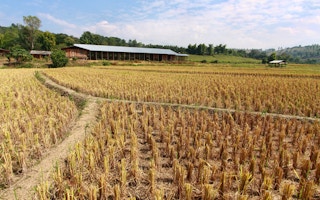The El Nino weather pattern that can trigger drought in some parts of the world while causing flooding in others is increasingly likely to return this year, hitting production of key foods such as rice, wheat and sugar.
El Nino - the Spanish word for boy - is a warming of sea-surface temperatures in the Pacific that occurs every four to 12 years. The worst on record in the late 1990s killed more than 2,000 people and caused billions of dollars in damage.
A strong El Nino can wither crops in Australia, Southeast Asia, India and Africa when other parts of the globe such as the US Midwest and Brazil are drenched in rains.
While scientists are still debating the intensity of a potential El Nino, Australia’s Bureau of Meteorology and the US Climate Prediction Center have warned of increased chances one will strike this year.
Last month, the United Nations’ World Meteorological Organisation said there was an “enhanced possibility” of a weak El Nino by the middle of 2014.
“
The specter of El Nino has driven global cocoa prices to 2-1/2 year peaks this month on fears that dry weather in the key growing regions of Africa and Asia would stoke a global deficit
“The world is bracing for El Nino, which if confirmed, could wreak havoc on supply and cause prices of some commodities to shoot up,” said Vanessa Tan, investment analyst at Phillip Futures in Singapore.
Any disruption to supply would come as many crops have already been hit by adverse weather, with the northern hemisphere in the grip of a savage winter.
The specter of El Nino has driven global cocoa prices to 2-1/2 year peaks this month on fears that dry weather in the key growing regions of Africa and Asia would stoke a global deficit. Other agricultural commodities could follow that lead higher if El Nino conditions are confirmed.
Bad boy
“Production estimates for several crops which are already under stress will have to be revised downwards,” said Phillip Futures’ Tan.
“Wheat in Australia may be affected by El Nino and also sugar in India.”
In India, the world’s No.2 producer of sugar, rice and wheat, a strong El Nino could reduce the monsoon rains that are key to its agriculture, curbing production.
“If a strong El Nino occurs during the second half of the monsoon season, then it could adversely impact the production size of summer crops,” said Sudhir Panwar, president of farmers’ lobby group Kishan Jagriti Manch.
El Nino in 2009 turned India’s monsoon patchy, leading to the worst drought in nearly four decades and helping push global sugar prices to their highest in nearly 30 years.
Elsewhere in Asia, which grows more than 90 per cent of the world’s rice and is its main producer of coffee and corn, a drought-inducing El Nino could hit crops in Thailand, Indonesia, Vietnam, the Philippines and China.
And it could deal another blow to wheat production in Australia, the world’s second-largest exporter of the grain, which has already been grappling with drought in the last few months.
El Nino could also crimp supply of minerals such as gold, nickel, tin, copper and coal if mines flood or logistics are disrupted.
In North America, crops in the US Pacific Northwest could suffer as El Nino tends to cause rain to the area, with the major white wheat region already abnormally dry.
But El Nino doesn’t spell bad news for all farmers. It could bring rain to drought-hit California’s dairy farms and vineyards.
“El Nino has a bad connotation, undeservedly so in the US,” said Harry Hillaker, state climatologist in Iowa.
“Given the water supply issues they are having in California, more rain would be helpful.”
And in Central America, while dryness associated with El Nino would curb coffee production, it would also help drive back the leaf rust that has blighted crops in the region.








